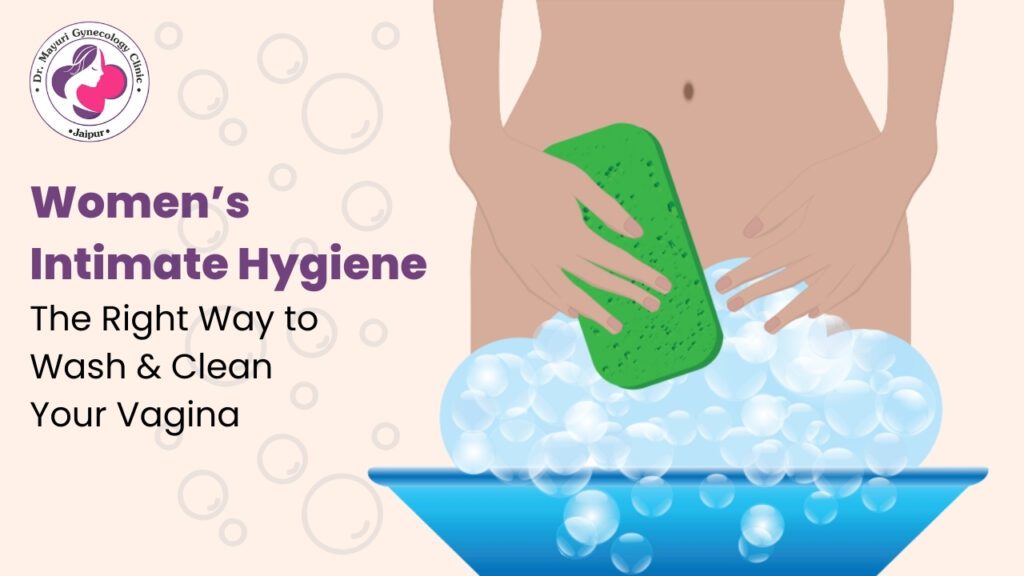Women’s Intimate Hygiene – The Right Way to Wash & Clean Your Vagina

Proper hygiene in the intimate area is an important factor in maintaining women’s overall health and comfort. The intimate area is sensitive and requires gentle care to ensure it stays clean, healthy, and free from infections. Many women are unsure how to wash this area correctly or which products are safe to use. Some even face issues like irritation, unpleasant odor, or infections due to improper hygiene or unnecessary harsh chemicals.
This blog covers everything about intimate hygiene, including how to wash correctly and maintain a healthy intimate area. We will also explore safe hair removal methods for the area to minimize side effects while promoting comfort.
What Is Intimate Hygiene?
Intimate hygiene means keeping the external genital area clean and healthy. Unlike other parts of the body, the vaginal area has its own self-cleansing mechanism and a natural balance of bacteria that protects it from harmful microorganisms. This means that the vagina does not need aggressive washing or chemical-based products but rather gentle care to avoid disrupting its natural environment.
The Role of the Vaginal Ecosystem
The vagina has a slightly acidic pH level, ranging between 3.8 and 4.5, which helps prevent infections and irritation. Good bacteria, such as lactobacilli, thrive in this environment and protect against harmful bacteria and yeast.
When harsh soaps or scented products are used, this delicate balance can be disturbed, leading to problems like bacterial vaginosis, yeast infections, itching, and foul odor.
Why Is Intimate Hygiene Important?
Proper intimate hygiene helps you:
✔ Prevent infections like yeast infections and urinary tract infections (UTIs)
✔ Control unpleasant odors
✔ Avoid irritation and inflammation
✔ Maintain natural moisture without excessive dryness
✔ Support overall comfort during menstruation, pregnancy, or exercise
However, it’s equally important to understand that the vagina cleans itself naturally. What you need to clean is the external genital area (vulva), not the inner vaginal canal.
How Often Should You Clean the Intimate Area?
Daily cleaning is sufficient for most women. Twice daily washing during menstruation or heavy sweating days is also recommended. Over-washing can remove natural oils, causing dryness and irritation. The frequency depends on factors like skin type, lifestyle, and menstrual cycle.
The Right Way to Wash Your Vagina
✅ Step 1: Use Lukewarm Water or a Mild Intimate Wash
For daily cleaning, lukewarm water alone is often enough. If you prefer using an intimate wash, choose one that is:
- pH-balanced between 3.5 and 4.5
- Free from harsh chemicals, parabens, and fragrances
- Soothing ingredients like Aloe vera or lactic acid.
Avoid body soaps or heavily fragranced products as they can disrupt the natural flora.
✅ Step 2: Clean Gently Without Scrubbing
Use your clean hands to softly cleanse the outer area. Avoid using loofahs, sponges, or scrubbing tools that can cause abrasions and irritation.
Focus on cleaning folds like:
- Labia majora (outer lips)
- Labia minora (inner lips)
- Clitoral hood
Gently rinse off sweat, discharge, and residue.
✅ Step 3: Wipe From Front to Back
Always clean from the vagina toward the anus to prevent bacteria from entering the vaginal canal. This small but important step reduces the risk of infections like UTIs.
✅ Step 4: Dry Properly
After washing, gently dry the area with a soft towel to avoid irritation. Avoid rubbing the skin aggressively.
Moisture buildup can encourage fungal infections, especially during humid weather or after sweating. Keep a separate towel or unscented wipes for the intimate area.
✅ Step 5: Apply a Moisturizer if Needed
Just like other body parts, this area can become dry, especially during winter or after frequent washing. Applying a moisturizer suitable for your skin helps keep the area soft and elastic.
Women with dry skin may need to moisturize more frequently, while those with oily skin can use lighter products once a day.
Special Care During Menstruation
Menstruation requires extra attention:
- Change pads or tampons every 4-6 hours
- Clean the area twice daily with water or gentle cleansers
- Avoid excessive washing
- Wear breathable cotton underwear.
- Stay hydrated to support healthy discharge
What Not to Do
❌ Do not wash inside the vagina – it’s self-cleaning
❌ Avoid douching or inserting water or soaps into the vaginal canal
❌ Do not use harsh or fragranced soaps
❌ Avoid wearing tight synthetic clothes that trap moisture
❌ Don’t overuse products even if you feel discomfort
Hair Removal in the Intimate Area – Safe Methods
Removing hair from the intimate area is a personal choice. However, the methods you use should be gentle and safe to avoid infections, ingrown hairs, and skin damage.
Why is there hair in that area in the first place?
The pubic hair is dense and thick due to hormonal influences after puberty. It helps:
- Regulate temperature
- Provide a barrier against infections and bacteria
- Protect sensitive skin from friction
Temporary Hair Removal Methods
1️⃣ Shaving
- Advantages: Fast, easy, and can be done at home
- Disadvantages: Causes razor bumps, irritation, ingrown hairs, and dark spots with frequent use
2️⃣ Hair Removal Creams
- Advantages: Easy and painless
- Disadvantages: Can cause allergic reactions or burns if not patch-tested first; skin tone may dull with repeated use
3️⃣ Trimming
- Advantages: Prevents irritation and maintains hygiene without removing hair completely
- Disadvantages: Time-consuming and requires care
4️⃣ Waxing
- Advantages: Removes hair from the root and keeps the area clean for longer (up to 3-4 weeks)
- Disadvantages: Painful, can cause irritation, redness, and darkening with repeated sessions
Choosing the Right Method for You
Every woman’s body is different, so what works for one might not work for another. When selecting hygiene or hair removal methods, consider:
✔ Your skin type – dry, oily, or sensitive
✔ Any allergies or reactions you have had in the past
✔ Your lifestyle, routine, and budget
✔ Professional advice from a dermatologist or gynecologist
Start with patch tests, and always opt for products or treatments that are clinically approved and recommended by healthcare experts.
Conclusion
Good intimate hygiene doesn’t require elaborate routines or harsh chemicals—it’s about understanding how your body works and supporting it with gentle care. The vagina is a self-cleaning organ, so washing the inner canal is unnecessary and can even cause harm. Focus on cleaning the outer vulva with mild, pH-balanced products, keeping the area dry, and using breathable clothing.
For hair removal, temporary methods like shaving or creams are convenient but may have side effects, while laser treatments offer more lasting solutions when done by trained professionals.
Listen to your body, understand its needs, and choose products and methods that suit your unique skin type and lifestyle. With proper knowledge and care, you can confidently maintain intimate hygiene, stay comfortable, and prevent infections.


